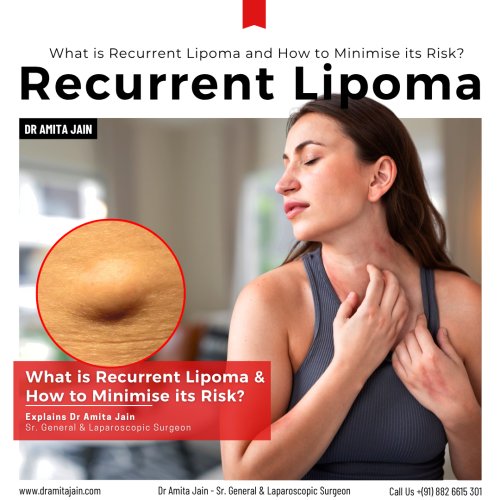A lipoma is a benign (non-cancerous) tumour composed of fatty tissue that typically develops just under the skin. These soft, rubbery lumps are usually painless and slow-growing. Although a single lipoma is common and generally harmless, some individuals experience recurrent lipomas, either the same lipoma returning after removal or new lipomas forming over time.
Understanding why lipomas recur and how to reduce the chances of their return is crucial, especially for individuals with a history of these fatty growths, says Dr Amita Jain, a leading laparoscopic surgeon and one of the best surgeons and doctors for lipoma treatment.
What is a Recurrent Lipoma?
Recurrent lipomas are generally not life-threatening, but they can cause discomfort, cosmetic concerns, or anxiety, especially if they grow large, become painful, or return frequently. Recurrent lipoma can refer to two situations:
- Local recurrence – the same lipoma reappears in the same spot after surgical removal.
- Multiple lipomatosis – a condition where an individual develops multiple lipomas over time, sometimes across different areas of the body.
Causes of Lipoma Recurrence
While the exact cause of lipomas is still not fully understood, several factors are associated with their development and recurrence:
- Genetic predisposition: Hereditary conditions such as familial multiple lipomatosis increase the likelihood of developing multiple lipomas throughout life.
- Incomplete surgical removal: If even a small portion of the lipoma tissue remains after surgery, the lipoma may regrow in the same spot.
- Hormonal or metabolic imbalance: Lipomas are sometimes associated with metabolic disorders, obesity, and hormonal changes.
- Trauma or injury: In some rare cases, lipomas may develop at the site of previous trauma or tissue injury.
How to Minimise the Risk of Recurrent Lipomas?
Although there is no guaranteed way to prevent lipomas completely, certain lifestyle changes and medical strategies may help reduce their recurrence or slow down their development:
Opt for Complete Surgical Removal – When removing a lipoma, especially if it’s large or deep, it’s crucial that the entire fatty lump, including its capsule, is excised. Consult an experienced surgeon or dermatologist who ensures clean surgical margins to reduce the chance of recurrence at the same site.
Monitor Genetic Risk – If you have a family history of lipomas, especially multiple or recurrent ones, speak with a genetic counsellor or your healthcare provider. Although there’s no cure for inherited lipomatosis, early detection and regular monitoring can help manage the condition proactively.
Maintain a Healthy Weight – While lipomas are not directly caused by obesity, a healthy lifestyle and balanced diet can help improve your body’s overall metabolic health. Reducing excess body fat may lower your chances of developing additional lipomas.
Avoid Unnecessary Trauma – Although rare, some lipomas form at the site of injuries. Protecting your skin and soft tissue from repeated trauma, especially in high-risk areas, can help lower this potential trigger.
Consider Liposuction for Larger Lipomas – In cases where traditional excision leaves visible scarring or is impractical, liposuction may be used to remove deeper or larger lipomas. However, liposuction may have a slightly higher recurrence rate, as it can be more challenging to remove the entire capsule completely.
Follow-up and Self-Check – After lipoma removal, regular follow-ups with your doctor are essential to ensure proper healing and detect any signs of recurrence early. Also, perform routine self-checks for new lumps and report any changes in size, shape, or sensation.
When to See a Doctor for Lipoma?
While lipomas are mostly harmless, consult a doctor if:
- A lump is rapidly growing
- It becomes painful or red
- It’s located deep within muscles or tissues
- You develop multiple new lumps in a short time
These could indicate a different condition or require further investigation, such as a biopsy or imaging test. Recurrent lipomas, though benign, can be frustrating and concerning. While complete prevention isn’t always possible, early medical intervention, a healthy lifestyle, and awareness of family history can help minimise their risk. If you notice any unusual or recurring lumps, don’t ignore them—timely consultation with a healthcare provider ensures peace of mind and appropriate care.

Dr Amita Jain is one of India’s most distinguished and experienced female surgeons, known for her unmatched expertise in general and laparoscopic surgery. With over 29 years of surgical excellence, Dr Amita Jain has built a reputation for precision, compassionate care, and advanced surgical techniques.
Dr Amita Jain has successfully performed a wide range of complex general surgeries, including both open and minimally invasive procedures, with a strong focus on trauma care, onco-surgical techniques, and reconstructive surgeries. Her areas of specialisation include (including Gallbladder stone removal, appendix removal, hernia repair surgery, piles and fissure surgeries). She was the Professor of Surgery at the Army College of Medical Sciences and Base Hospital, Delhi Cantt. In 1994, she was commissioned asa Surgeon under the United Nations Mission in Congo. From 2020 to 2022, she worked with Bansals Hospital. Currently, Dr Amita Jain is the Senior General and Laparoscopic Surgeon at Rainbow Children Hospitals (Malviya Nagar, Delhi), Artemis Lite: Multi-Speciality Care Hospital (New Friends Colony, New Delhi) and at Rosewalk – Luxury Maternity Hospital in Delhi (Panchsheel Park, Delhi)
Call Us at +(91) 882-6615301

